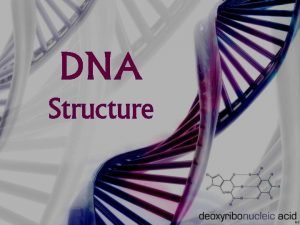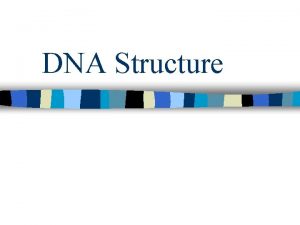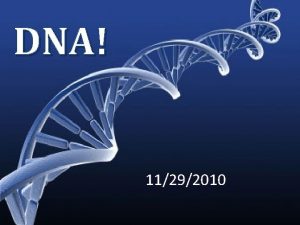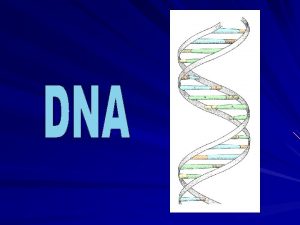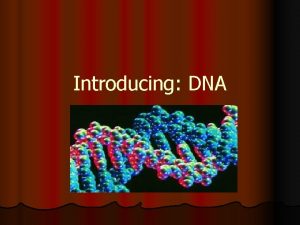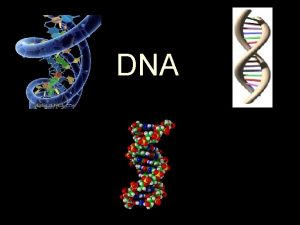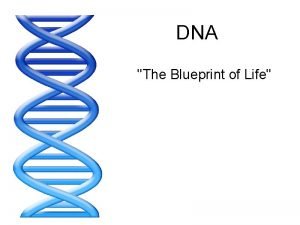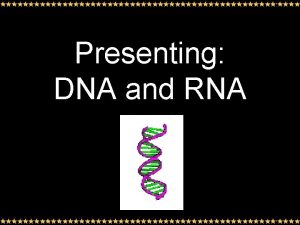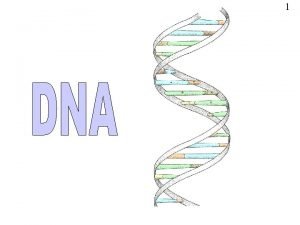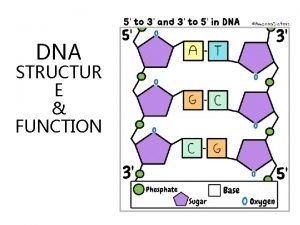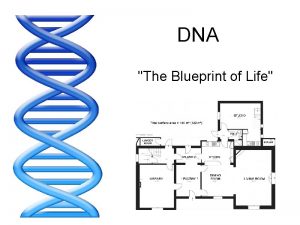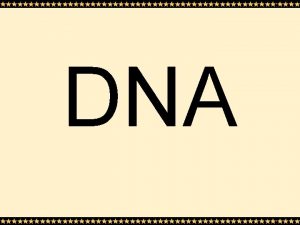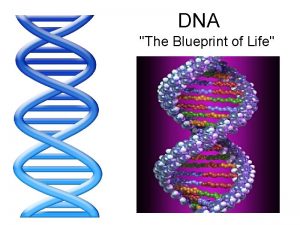DNA Analysis What is DNA DNA stands for




















- Slides: 20

DNA Analysis

What is DNA? DNA stands for deoxyribonucleic acid and contains genetic information. It is found on chromosomes located in the nucleus of our cells. What makes up DNA? • The sides or backbone of the DNA molecule are made up of sugar (deoxyribose) and phosphate molecules. Double Helix • The rungs that form the middle of the molecule are made up of pairs of nucleotides or nitrogen bases. Adenine (A) pairs with thymine (T), while guanine (G) always pairs with cytosine (C). • The order of the bases determines the genetic code. DNA Image: http: //science. howstuffworks. com/genetic-science/dna-evidence. htm

General DNA Information Double helix—two coiled DNA strands Composed of nucleotides—units containing a sugar molecule (deoxyribose), a phosphate group, and a nitrogen -containing base In humans, the order of these bases is 99. 9% the same. Four bases: • Adenine Cytosine Guanine Bases always pair A to T and G to C. jyokum 2013 Thymine

Where Is DNA Found? jyokum 2013

DNA Typing jyokum 2013

Uses of DNA Fingerprinting To identify potential suspects To exonerate individuals To identify crime and casualty victims To establish paternity To match organ donors jyokum 2013

DNA Typing “Fingerprinting” 1985—Alec Jeffreys jyokum 2013

RFLP—Restriction Fragment Length Polymorphisms Restriction enzymes are used to cut DNA into smaller fragments that can then be separated and characterized for identification. Isolate—separate DNA from the cell Cut—use of restriction enzymes to make shorter base strands Sort—by size using electrophoresis Analyze—the specific alleles for identification jyokum 2013

PCR—Polymerase Chain Reaction PCR is a technique used for making copies of a defined segment of a DNA molecule. This can be valuable when the amount of evidence is minimal. Millions of copies of DNA can be made from a single speck of blood. The outcome is a doubling of the number of DNA strands. Heating, cooling, and strand rebuilding is repeated typically 25 to 30 times, yielding more than one million copies of the original DNA molecule. Each cycle takes less than two minutes from start to finish jyokum 2013

Advantages of PCR Minute amounts of DNA may be used for amplification. DNA degraded to fragments only a few hundred base pairs in length can serve as effective templates for amplification. Large numbers of copies of specific DNA sequences can be amplified simultaneously with multiplex PCR reactions. Commercial kits are now available for easy PCR reaction setup and amplification. Contaminant DNA, such as from fungal and bacterial sources, will not amplify because human-specific primers are used. However, human contamination can be a problem. jyokum 2013

Electrophoresis A technique used to separate DNA fragments An electrical current is moved through a gel substance, causing molecules to sort by size. The smaller, lighter molecules will move the farthest on the gel. After developing, the fragments can be visualized for characterization. jyokum 2013

Short Tandem Repeats (STR) STR is another method of DNA typing. STRs are locations (loci) on the chromosome that contain short sequences of two to five bases that repeat themselves in the DNA molecule. The advantages of this method are 1. provides greater discrimination 2. requires less time 3. a smaller sample size, 4. DNA is less susceptible to degradation. jyokum 2013

Short Tandem Repeats (STR) • STR typing is visualized by peaks shown on a graph. Each represents the size of the DNA fragment. • The possible alleles are numbered for each locus. jyokum 2013

Determining Probability • Databases have been established that determine how often a particular allele on a locus appears in a given population. By increasing the number of alleles on different loci, the probability of having two people with the exact combination becomes minuscule. jyokum 2013

Three Possible Outcomes of DNA Profiling • Match—The DNA profile appears the same. Lab will determine the frequency. • Exclusion—The genotype comparison shows profile differences that can only be explained by the two samples originating from different sources. • Inconclusive—The data do not support a conclusion as to whether the profiles match. jyokum 2013

Types of DNA • Nuclear – Found in the nucleus – Constitutes 23 pairs of chromosomes inherited from both parents – Each cell contains only one nucleus Mitochondrial Found in the cytoplasm Is inherited only from mother Each cell contains hundreds to thousands of mitochondria Can be found in skeletal remains jyokum 2013

Mitochondrial DNA • Nuclear DNA is present in the head of the sperm. Mitochondrial DNA is present in the tail. At conception, the head of the sperm enters the egg and unites with the nucleus. The tail falls off, losing the father’s mitochondrial DNA. • • Analysis of m. DNA is more: Rigorous Time-consuming Costly than nucleic testing of DNA jyokum 2013

What factors affect DNA evidence? Several factors can affect the DNA left at a crime scene, such as environmental factors (e. g. , heat, sunlight, moisture, bacteria, and mold). Therefore, not all DNA evidence will result in a usable DNA profile. Further, DNA testing cannot identify when the suspect was at the crime scene or for how long. What is CODIS? CODIS stands for COmbined DNA Index System, which is an electronic database of DNA profiles that can identify suspects. DNA profiles from individuals convicted of certain crimes, such as rape, murder, and child abuse, are entered into CODIS and help officers identify possible suspects when no prior suspect existed. Did you know? Each human cell contains three billion DNA base pairs. Our unique DNA amounts to 0. 1% or 3 million base pairs. DNA information : http: //www. dna. gov/audiences/investigators/know/

FBI’s CODIS DNA Database • Combined DNA Index System • Used for linking serial crimes and unsolved cases with repeat offenders • Launched October 1998 • Links all 50 states • Requires >4 RFLP markers and/or 13 core STR markers jyokum 2013

C. Identical or not? A. Who done it? Which sets of twins are identical twins? Which suspect matches the bloodstain? B. Whose your daddy? Which sample is most likely to be the father? F 1 or F 2 Information & image from http: //www. teachersdomain. org/resource/tdc 02. sci. life. gen. lp_dnamysteries/
 Dna stands for deoxyribonucleic acid
Dna stands for deoxyribonucleic acid Dna stands for
Dna stands for Deoxyribose sugar
Deoxyribose sugar Dna center vm
Dna center vm Kontinuitetshantering i praktiken
Kontinuitetshantering i praktiken Typiska drag för en novell
Typiska drag för en novell Tack för att ni lyssnade bild
Tack för att ni lyssnade bild Ekologiskt fotavtryck
Ekologiskt fotavtryck Varför kallas perioden 1918-1939 för mellankrigstiden
Varför kallas perioden 1918-1939 för mellankrigstiden En lathund för arbete med kontinuitetshantering
En lathund för arbete med kontinuitetshantering Personalliggare bygg undantag
Personalliggare bygg undantag Personlig tidbok fylla i
Personlig tidbok fylla i A gastrica
A gastrica Densitet vatten
Densitet vatten Datorkunskap för nybörjare
Datorkunskap för nybörjare Stig kerman
Stig kerman Debattinlägg mall
Debattinlägg mall Delegerande ledarskap
Delegerande ledarskap Nyckelkompetenser för livslångt lärande
Nyckelkompetenser för livslångt lärande Påbyggnader för flakfordon
Påbyggnader för flakfordon Arkimedes princip formel
Arkimedes princip formel

